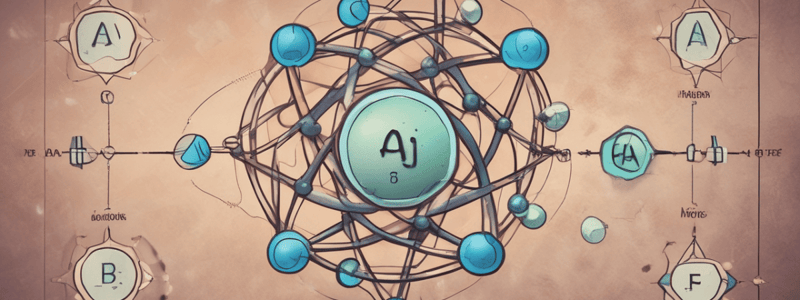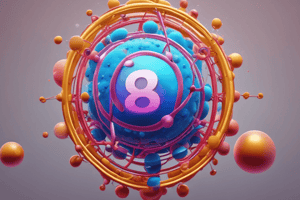Podcast
Questions and Answers
What results from the sharing of six electrons between two atoms?
What results from the sharing of six electrons between two atoms?
What happens to a sodium atom when it loses one electron?
What happens to a sodium atom when it loses one electron?
Which of the following best defines a molecule?
Which of the following best defines a molecule?
How do atoms achieve electrical neutrality in ionic bonds?
How do atoms achieve electrical neutrality in ionic bonds?
Signup and view all the answers
Which type of bond involves electrons traveling about the nuclei of both atoms?
Which type of bond involves electrons traveling about the nuclei of both atoms?
Signup and view all the answers
What is the charge on a chloride ion?
What is the charge on a chloride ion?
Signup and view all the answers
In the context of chemical bonds, what term best describes valence electrons?
In the context of chemical bonds, what term best describes valence electrons?
Signup and view all the answers
What is the primary characteristic of an ionic bond?
What is the primary characteristic of an ionic bond?
Signup and view all the answers
Which property is NOT associated with the compound sodium chloride?
Which property is NOT associated with the compound sodium chloride?
Signup and view all the answers
What is the chemical formula for water?
What is the chemical formula for water?
Signup and view all the answers
Which isotope is used to follow the movements of substances within organisms?
Which isotope is used to follow the movements of substances within organisms?
Signup and view all the answers
Which element is NOT paired correctly with its chemical property?
Which element is NOT paired correctly with its chemical property?
Signup and view all the answers
How do geologists use radioactive isotopes?
How do geologists use radioactive isotopes?
Signup and view all the answers
What combination forms liquid water?
What combination forms liquid water?
Signup and view all the answers
Which use is NOT listed for radioactive isotopes?
Which use is NOT listed for radioactive isotopes?
Signup and view all the answers
Which statement about the physical properties of chemical compounds is accurate?
Which statement about the physical properties of chemical compounds is accurate?
Signup and view all the answers
What defines the chemical properties of an element?
What defines the chemical properties of an element?
Signup and view all the answers
What is the atomic number of an element?
What is the atomic number of an element?
Signup and view all the answers
Which of these statements is correct regarding isotopes?
Which of these statements is correct regarding isotopes?
Signup and view all the answers
What is the mass number of an atom?
What is the mass number of an atom?
Signup and view all the answers
How does the abundance of an isotope in nature affect its atomic mass?
How does the abundance of an isotope in nature affect its atomic mass?
Signup and view all the answers
Which element is NOT commonly found in living organisms?
Which element is NOT commonly found in living organisms?
Signup and view all the answers
Why do different elements have such differing properties?
Why do different elements have such differing properties?
Signup and view all the answers
Which carbon isotope is radioactive?
Which carbon isotope is radioactive?
Signup and view all the answers
Which scientist introduced the concept of the atom nearly 2,500 years ago?
Which scientist introduced the concept of the atom nearly 2,500 years ago?
Signup and view all the answers
How many sulfur atoms placed side-by-side would approximately equal the width of a pinky finger?
How many sulfur atoms placed side-by-side would approximately equal the width of a pinky finger?
Signup and view all the answers
Which subatomic particle has no charge?
Which subatomic particle has no charge?
Signup and view all the answers
Where in the atom do protons and neutrons reside?
Where in the atom do protons and neutrons reside?
Signup and view all the answers
What is the mass of an electron relative to a proton?
What is the mass of an electron relative to a proton?
Signup and view all the answers
How many electrons can the first shell of an atom hold?
How many electrons can the first shell of an atom hold?
Signup and view all the answers
What ensures that atoms are electrically neutral?
What ensures that atoms are electrically neutral?
Signup and view all the answers
Which force binds protons and neutrons together in the nucleus?
Which force binds protons and neutrons together in the nucleus?
Signup and view all the answers
What allows geckos to scurry up walls and across ceilings?
What allows geckos to scurry up walls and across ceilings?
Signup and view all the answers
What is the main function of the weak interactions within a living cell?
What is the main function of the weak interactions within a living cell?
Signup and view all the answers
Which statement BEST describes van der Waals forces?
Which statement BEST describes van der Waals forces?
Signup and view all the answers
What is the composition of the projections on a gecko's feet that assist in van der Waals interactions?
What is the composition of the projections on a gecko's feet that assist in van der Waals interactions?
Signup and view all the answers
Why are hydrogen bonds essential to understanding the special properties of water?
Why are hydrogen bonds essential to understanding the special properties of water?
Signup and view all the answers
What characteristic of molecules enhances the effectiveness of van der Waals forces?
What characteristic of molecules enhances the effectiveness of van der Waals forces?
Signup and view all the answers
What term is used to describe the shared action or influence between molecules?
What term is used to describe the shared action or influence between molecules?
Signup and view all the answers
Which atoms in a neighboring molecule can form hydrogen bonds with a hydrogen atom?
Which atoms in a neighboring molecule can form hydrogen bonds with a hydrogen atom?
Signup and view all the answers
Study Notes
Elements and Isotopes
- A chemical element is a pure substance that consists entirely of one type of atom.
- Elements are represented by one or two-letter symbols.
- The number of protons in the nucleus of an element is called its atomic number.
- Carbon's atomic number is 6, meaning that each atom of carbon has six protons and six electrons.
- Nearly 100 naturally occurring chemical elements exist on Earth, but fewer than 20 are commonly found in living organisms.
- About 99% of the mass of living things is composed of just six elements: calcium, carbon, hydrogen, oxygen, nitrogen, and phosphorus.
- The remaining 1% of elements are also essential and are known as trace elements.
Isotopes
- Atoms of an element may have different numbers of neutrons.
- Atoms of the same element that differ in the number of neutrons they contain are known as isotopes.
- The total number of protons and neutrons in the nucleus of an atom is called its mass number.
- Isotopes are identified by their mass numbers.
- The weighted average of the masses of an element's isotopes is called its atomic mass.
- Neutrons affect the atomic mass of an isotope but do not affect its chemical properties.
Radioactive Isotopes
- Radioactive isotopes are unstable and break down at a constant rate over time.
- Radioactive isotopes have important scientific and practical uses, such as:
- Determining the ages of rocks and fossils
- Detecting cancer and killing bacteria that cause food to spoil
- Using as labels or "tracers" to follow the movements of substances within organisms
Chemical Compounds
- A chemical compound is a substance formed by the chemical combination of two or more elements in definite proportions.
- Scientists show the composition of compounds by a kind of short-hand known as a chemical formula.
- The physical and chemical properties of a compound are usually very different from those of the elements from which it is formed.
Chemical Bonds
- The atoms in compounds are held together by chemical bonds.
- The main types of chemical bonds are:
- Ionic bonds: formed when one or more electrons are transferred from one atom to another
- Covalent bonds: formed when electrons are shared between atoms
- Bond formation involves the electrons that surround each atomic nucleus.
Weak Interactions
- Weak interactions between atoms and molecules are important in living things.
- Examples of weak interactions include:
- Van der Waals forces: a slight attraction between molecules when they are very close together
- Hydrogen bonds: form between a hydrogen atom of one molecule and an oxygen or nitrogen atom of a neighboring molecule
Studying That Suits You
Use AI to generate personalized quizzes and flashcards to suit your learning preferences.
Description
Learn about the basics of chemical elements, their symbols, atomic numbers, and the structure of atoms. Understand the concept of isotopes and how they differ from elements.




